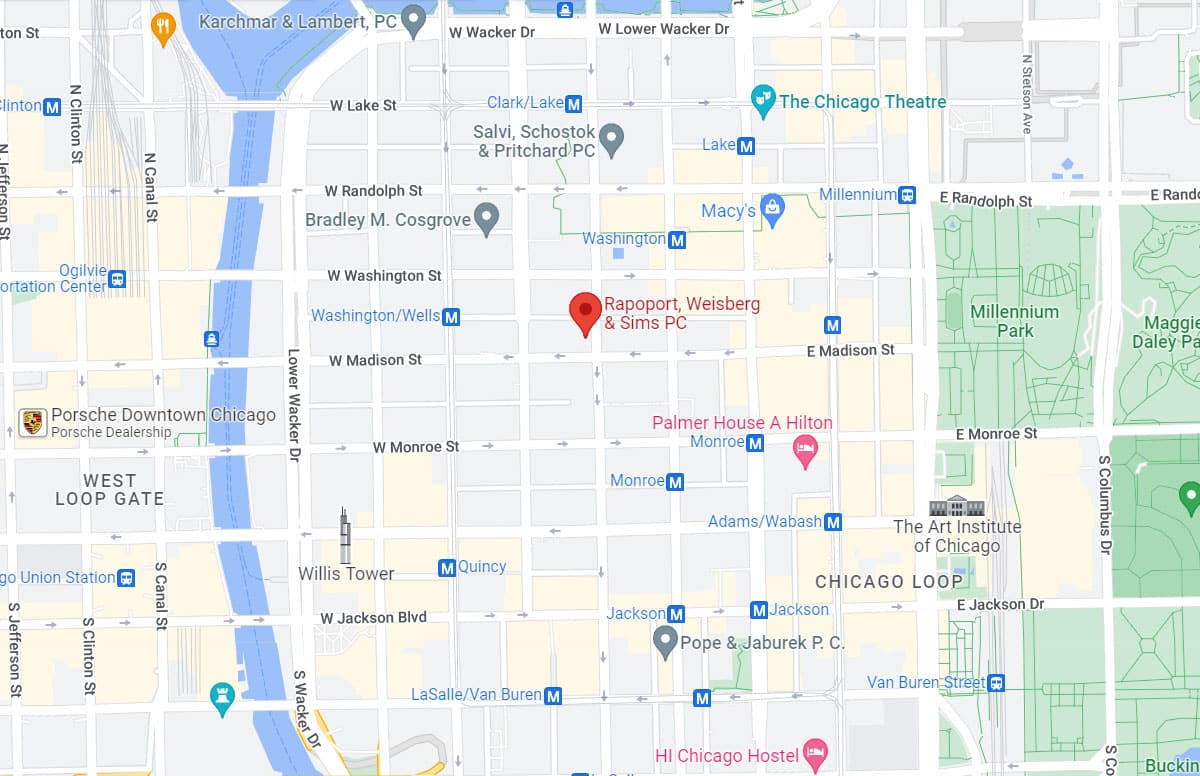Rapoport Weisberg Sims & VanOverloop P.C. is currently evaluating personal injury cases involving the recent Alaska Air Flight 1282 Incident that caused harm to numerous passengers.
If you suffered injuries in the incident, contact our Alaska Air injury lawyers right away for a free, no-obligation consultation. You may be able to make a claim against Boeing, Alaska Airlines, or others involved in the plane’s maintenance and modifications, or a combination of the parties.
Our aviation accident lawyers have more than three decades of experience representing commercial aircraft accident victims, crew members, and their families across the United States, and we’ve recovered over $500 million in settlements and jury verdicts on behalf of our clients.
What Happened in the Alaska Airlines Flight 1282 Incident?
On Friday, January 5, 2024, an Alaska Airlines Boeing 737 Max 9 aircraft was forced into an emergency landing approximately six minutes after takeoff when a “plugged” emergency exit door detached from the plane mid-flight. The aircraft, which was carrying 171 passengers and six crew members, was left with a gaping hole in its left side. Pilots initiated an emergency descent and an emergency landing, returning to the Portland International Airport, where the plane landed safely.

Remarkably, no lives were lost, although many passengers were left with physical injuries and emotional trauma that will likely lead to lifelong scars.
What Caused the Fuselage Blowout? Inside the Investigation of Alaska Air Flight 1282
The Federal Aviation Administration (FAA) has announced a formal investigation into Boeing’s 737 Max 9 aircraft. The investigation stems from the recent emergency exit plug door incident as well as from additional discrepancies regarding the aircraft.
The FAA says the investigation will help to determine whether the airplane manufacturing giant failed to ensure that the jets conformed to the approved design, whether they were “in a condition for safe operation”, and whether Boeing was in compliance with FAA regulations. The FAA also announced increased oversight of Boeing’s production and manufacturing operations in the future. Shockingly, this all comes in the wake of lawsuits following the crashes of two Boeing 737 Max 8 airplanes that resulted in the deaths of 346 people.
Investigations by Alaska Airlines and United Airlines, which are the only two airlines in the United States that fly the 737 Max 9 aircraft, revealed loose bolts inside several other door plugs on the jets. These bolts are designed to prevent the door plug from moving upward and disengaging from the stop fittings.
The National Transportation Safety Board (NTSB) is utilizing its forensic laboratory to determine whether the bolts on the plane in question were ever installed. Part of the focus of the investigation will involve microscopic inspections of witness marks on the fuselage and recovered door.
Regarding this particular aircraft, the NTSB is conducting an investigation into the entire history of this plane, from the start of production and when the door plug was put into service, to when the plane landed back in Portland after the incident. They will also consider numerous pressurization alerts that went off in the days leading up to the incident, as well as information from the flight data recorder (FDR), sometimes referred to as the “black box.”
Although the cockpit voice recorder (CVR) may have been able to provide more insight into what happened on Flight 1282, the recording was erroneously recorded over, and all voice activity was erased.
Theories Surrounding the Cause of the Exit Door Blowout
There are several factors that may have played a role in the incident. Determining the cause of the blowout is vital for identifying defendants. Based on the information known at this point, several reasons for the door detaching may include:
Inadequate Design
The plug assembly may not have been designed to withstand diverse flight conditions. Investigators will need to review the structural margins to determine whether a more robust design could have prevented the incident. Investigators will be looking closely at whether the fittings for the attachment bolts were an appropriate selection to affix the door plug.
Damaged Parts
Boeing may have received a damaged door plug from its supplier. Approximately one month prior to the incident, complaints by former employees of the supplier alleged that various products from the fuselage manufacturer frequently contained defects.
Manufacturing Defect
It’s possible that bolts were improperly installed or not installed at all during the assembly process. Loose bolts may have enabled the emergency exit door plug to disengage from the stop fittings, allowing the assembly to fly off of the aircraft.
Improper Maintenance
Improper servicing by technicians could have compromised the plug assembly’s security, enabling aerodynamic forces to dislodge it. Investigators will review servicing records and procedures to determine whether improper maintenance played a role in the door plug failure.
Structural Damage
External damage could have caused flaws that compromised the plug’s attachment points or peripheral structures, resulting in the unexpected failure of the emergency exit plug assembly, although this seems unlikely at this point.
Can Passengers Make Claims for Injuries Caused by the Flight 1282 Door Plug Blowout?
If you suffered physical or emotional injuries that were caused by the Flight 1282 emergency door plug detachment and the rapid decompression that followed, you may be able to make claims to recover compensation.
You don’t have to have physical injuries to have a valid lawsuit. You must have suffered some type of injury or loss, however. Examples of injuries and losses that may have been caused by the incident include:
- Physical injuries caused by flying debris
- Barotrauma from rapid decompression, which may include injuries to the ears, lungs or brain
- Psychological trauma from the terrifying event
- Hypoxia from the rapid decompression of the cabin
Injured in the Alaska Air Flight 1282 Incident? Our injury attorneys at Rapoport Weisberg Sims & VanOverloop P.C. can help you recover compensation. Call (312) 445-9160.
Who Might Passengers Make Claims Against for Injuries Caused by the Alaska Air Incident?
Our aviation accident lawyers are following FAA, NTSB, and other investigations closely to help identify the cause or causes of the Flight 1282 accident and determine who may be able to be held liable for passenger injuries and losses. Until more information becomes available, we won’t know who exactly will be defendants in the injury lawsuits. Possible liable parties include:
Boeing
Boeing may be held accountable for passengers’ physical injuries and psychological trauma, including developments of PTSD, if it is determined that the company’s manufacturing or practices fell below the standard of care.
Alaska Airlines
Alaska Airlines could be held liable for passenger injuries if it is determined that they failed to keep their passengers safe when the incident occurred. As a common carrier, the airline owes a higher standard of care to passengers than the standard obligation owed to prevent causing harm. Any failure to uphold the highest level of care consistent with the practical operation of their aircraft could be evidence of negligence.
Maintenance and Modification Subcontractors
If subcontractor technicians made mistakes when installing or performing maintenance on the plug assembly, their employers may be able to be held liable for injuries. Identifying any mistakes that may have been made, and who was responsible for making them, will be key in determining liability for injuries caused by the incident.
Spirit AeroSystems
The fuselage and door plug assembly of the aircraft was manufactured at Spirit AeroSystems in Wichita, Kansas. Spirit manufactures an average of two fuselages per day. Some media reports claim that the company has a history of quality lapses and production problems. If Spirit’s negligence contributed to the incident, the company may be held liable.
What Damages Can Flight 1282 Passengers Recover?
Various types of damages may be available to passengers who suffered physical or psychological injuries in the Alaska Air door plug incident. When estimating the value of your case, our commercial aviation accident attorneys will review the types of injuries you sustained, how the incident impacts your life, and the financial losses you have suffered, and may continue to suffer, because of the accident. You may be entitled to receive:
Economic Damages
Economic damages are those that are linked to your monetary losses that were caused by the incident. Examples include lost wages, as well as medical expenses like ambulance transport, emergency room costs, follow-up visits to doctors and mental health providers, medications, and more.
Non-Economic Damages
Non-economic damages, also referred to as general damages, are a little more difficult to quantify. They are subjective damages like physical pain, emotional trauma, psychological disability, and the loss of enjoyment of life. Additionally, non-economic damages may be available if the incident caused you to suffer undue stress because of the disruption in your travel plans, or for other reasons that developed because of the accident. Having deep experience with determining non-economic damages in commercial aviation incidents gives our attorney team the know-how to recover what you deserve.

